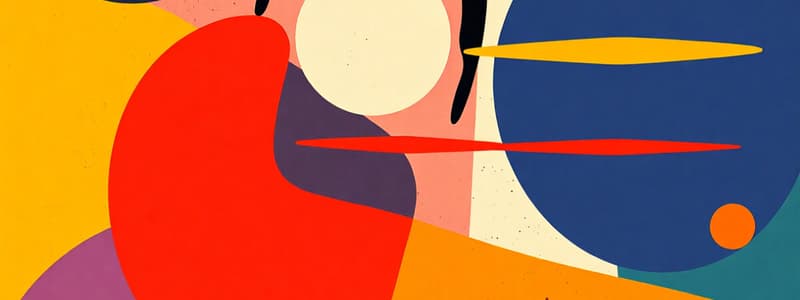Podcast
Questions and Answers
Which job is primarily focused on crafting stories through visual elements in motion?
Which job is primarily focused on crafting stories through visual elements in motion?
- UI/UX Designer
- Production Designer
- Animator (correct)
- Photo Editor
Which skill is essential for effectively conveying ideas and information in graphic design?
Which skill is essential for effectively conveying ideas and information in graphic design?
- Technical knowledge of computer hardware
- Knowledge of programming languages
- Understanding of audience targeting (correct)
- Basic math skills
What is the role of a Creative Director in a graphic design context?
What is the role of a Creative Director in a graphic design context?
- To manage social media accounts
- To create physical models for production
- To conduct customer surveys and research
- To oversee the overall design vision and direction (correct)
Which of the following is NOT listed as a typical employer for graphic designers?
Which of the following is NOT listed as a typical employer for graphic designers?
Which of the following skills would be least necessary for a Multimedia Specialist?
Which of the following skills would be least necessary for a Multimedia Specialist?
What is a defining feature of Swiss Design from the 1950s?
What is a defining feature of Swiss Design from the 1950s?
Which style primarily uses bold, contrasting colors?
Which style primarily uses bold, contrasting colors?
Which statement correctly contrasts Bauhaus and Swiss Design?
Which statement correctly contrasts Bauhaus and Swiss Design?
What visual characteristic distinguishes Art Nouveau from Art Deco?
What visual characteristic distinguishes Art Nouveau from Art Deco?
What role do technological innovations play in the history of graphic design?
What role do technological innovations play in the history of graphic design?
Which principle is NOT a basic characteristic of Swiss Design?
Which principle is NOT a basic characteristic of Swiss Design?
In terms of colors, how does Art Nouveau differ from Art Deco?
In terms of colors, how does Art Nouveau differ from Art Deco?
Which design principle emphasizes the importance of white or negative space in Swiss Design?
Which design principle emphasizes the importance of white or negative space in Swiss Design?
What is the primary focus of Graphic Design?
What is the primary focus of Graphic Design?
Which of the following is NOT a part of the history of Graphic Design discussed?
Which of the following is NOT a part of the history of Graphic Design discussed?
What significant change occurred during the Middle Ages and Industrial Revolution?
What significant change occurred during the Middle Ages and Industrial Revolution?
Which aspect is essential for success in various areas of Graphic Design?
Which aspect is essential for success in various areas of Graphic Design?
What is considered a source of inspiration in Graphic Design?
What is considered a source of inspiration in Graphic Design?
In the context of Graphic Design, what does 'Visual Communications' refer to?
In the context of Graphic Design, what does 'Visual Communications' refer to?
Which of the following best describes the role of history in graphic design?
Which of the following best describes the role of history in graphic design?
Which of the following is an important outcome for students in this lesson?
Which of the following is an important outcome for students in this lesson?
What was the primary purpose of the Bauhaus school?
What was the primary purpose of the Bauhaus school?
Which characteristic is most associated with Art Nouveau?
Which characteristic is most associated with Art Nouveau?
What influence did Art Deco primarily draw from?
What influence did Art Deco primarily draw from?
Which statement accurately describes the design philosophy of Art Deco?
Which statement accurately describes the design philosophy of Art Deco?
During which years did the Bauhaus operate?
During which years did the Bauhaus operate?
In what way did Art Nouveau react against contemporary trends?
In what way did Art Nouveau react against contemporary trends?
What was the goal of Art Nouveau as a design style?
What was the goal of Art Nouveau as a design style?
Which of the following styles is known for its lack of ornamentation?
Which of the following styles is known for its lack of ornamentation?
Flashcards
Graphic Design
Graphic Design
The art and profession of arranging visual elements like typography, images, and colors to communicate a message.
History of Graphic Design
History of Graphic Design
Understanding the evolution of graphic design, from ancient times to modern periods.
Cave Art
Cave Art
Early forms of visual communication found in caves, illustrating historical and cultural expressions.
Ancient Egyptians
Ancient Egyptians
Signup and view all the flashcards
Middle Ages
Middle Ages
Signup and view all the flashcards
Industrial Revolution
Industrial Revolution
Signup and view all the flashcards
Visual Communication
Visual Communication
Signup and view all the flashcards
Purpose of Graphic Design
Purpose of Graphic Design
Signup and view all the flashcards
Swiss Design
Swiss Design
Signup and view all the flashcards
Art Deco
Art Deco
Signup and view all the flashcards
Art Nouveau
Art Nouveau
Signup and view all the flashcards
Bauhaus
Bauhaus
Signup and view all the flashcards
What distinguishes Swiss Design from Bauhaus?
What distinguishes Swiss Design from Bauhaus?
Signup and view all the flashcards
What are the key principles of Swiss Design?
What are the key principles of Swiss Design?
Signup and view all the flashcards
What are the key differences between Art Nouveau and Art Deco?
What are the key differences between Art Nouveau and Art Deco?
Signup and view all the flashcards
What's the influence of technology on graphic design?
What's the influence of technology on graphic design?
Signup and view all the flashcards
Photo Editor
Photo Editor
Signup and view all the flashcards
Animator
Animator
Signup and view all the flashcards
Concept Artist
Concept Artist
Signup and view all the flashcards
Illustrator
Illustrator
Signup and view all the flashcards
UI/UX Designer
UI/UX Designer
Signup and view all the flashcards
Gutenberg's Invention
Gutenberg's Invention
Signup and view all the flashcards
Art Nouveau's Focus
Art Nouveau's Focus
Signup and view all the flashcards
Bauhaus's Mission
Bauhaus's Mission
Signup and view all the flashcards
Art Deco's Inspiration
Art Deco's Inspiration
Signup and view all the flashcards
What's Art Nouveau's Artistic Style?
What's Art Nouveau's Artistic Style?
Signup and view all the flashcards
What's the Impact of Bauhaus?
What's the Impact of Bauhaus?
Signup and view all the flashcards
What Defines Art Deco's Style?
What Defines Art Deco's Style?
Signup and view all the flashcards
How Did Art Deco Reflect Modernism?
How Did Art Deco Reflect Modernism?
Signup and view all the flashcards
Study Notes
Lesson 1: Design Fundamentals
- Course: ICT 8
- Quarter: Second Quarter
- School: Holy Rosary College of Sta. Rosa Laguna, Inc.
- School Year: 2024-2025
Learning Objectives
- Students will gain a general understanding of graphic design history.
- Students will identify different industries and career paths in graphic design.
- Students will identify skills necessary for success in various graphic design areas.
Rationale
- History provides insight into change.
- History offers a wealth of inspiration and design elements.
Graphic Design
- Graphic design is the art and profession of selecting and arranging visual components (typography, images, symbols, colors) to communicate a message to an audience.
- Graphic design is also referred to as Visual Communication.
History of Graphic Design
- Cave Art (Lascaux, France): 30,000 BCE
- Ancient Egyptians: 3200 BCE
- Middle Ages and Industrial Revolution: 1100-1453 AD. Development of mass production influenced culture from being primarily agricultural to a more industrialized way of life.
- The Printing Press (Gutenberg's): 1454 AD—leading to widespread mass communication.
- Art Nouveau (1890-1910): A style that aimed to challenge mass production and industrialization, with fluid and flat forms, curving and asymmetrical lines, going back to natural forms, influencing designers and furniture makers.
- The Bauhaus (1919-1933): A German artistic school that sought to merge artistic mediums into a unified approach. Aimed to bring order from chaos, promoting abstract forms, angular, geometric designs, and less ornamentation.
- Art Deco (1925-1940): Modernism turned into fashion, inspired by Cubism, using sleek geometric or stylized forms combined with man-made materials.
- Swiss Design (1950s): Minimalist graphics, a modular grid system, asymmetrical layouts, and sans-serif fonts defined the style, with white or negative space as the basis of modern graphic design.
History of Graphic Design Styles
- Part 1: Bauhaus and Art Nouveau, using a video resource.
- Part 2: Swiss Design and Art Deco, using a video resource.
Differences between Art Nouveau and Art Deco
- Art Nouveau: curving lines, organic forms, soft, muted colors, pastel shades.
- Art Deco: industrial forms, sharp edges, bold, contrasting colors, vivid hues.
Differences between Bauhaus and Swiss Design
- Bauhaus: same geometric shapes
- Swiss Design: different techniques, more colors and photography, using Helvetica font (exclusive).
Which Style?
- Example logos of different design styles (which is Art Nouveau, Swiss, Art Deco, and Bauhaus).
Evolution of Graphic Design
- Graphic design is shaped by technological innovations, societal needs, and the visual imagination of the designers.
Careers in Graphic Design
- Job Options: Photo editor, animator, concept artist, multimedia specialist, UI/UX designer, advertising art director, creative director, digital marketer, game artist, production designer (theater/TV/film), and interior and urban designer.
- Typical Employers: Advertising firms, creative agencies, design studios, publishing companies, media and communications companies, PR agencies.
Skills for Graphic Design
- Drawing and sketching, creativity and innovation, communication, understanding of audience targeting, and computer software skills.
Studying That Suits You
Use AI to generate personalized quizzes and flashcards to suit your learning preferences.




